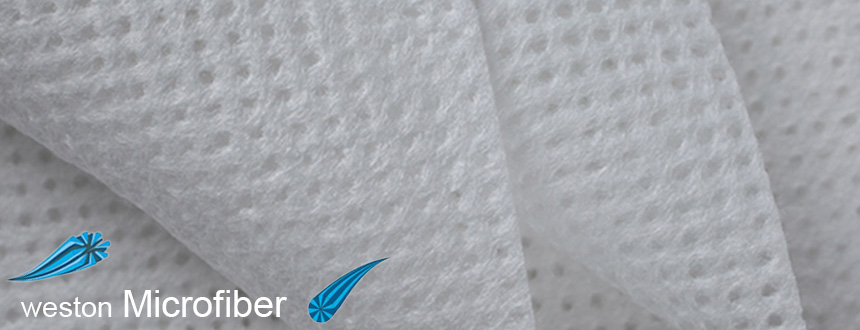Microfiber viscose spunlace is made from 50% microfiber and 50% viscose fiber.
Microfiber is a synthetic fabric made from a combination of polyester and polyamide (nylon) fibers. The fibers are extremely thin, typically measuring less than one denier, which is about one-sixth the diameter of a human hair. These fine fibers are then woven or knit together to create a highly absorbent and durable material.
Microfiber has several advantages, including:
Softness: Microfiber is known for its soft and luxurious feel. The fine fibers create a smooth surface that is gentle on the skin and can be comfortable to use.
Absorbency: Due to its dense and porous structure, microfiber has excellent absorbent properties. It can absorb and hold a significant amount of liquid compared to traditional fabrics. This makes it highly effective for cleaning tasks, such as mopping up spills or drying surfaces.
Cleaning power: The tiny fibers in microfiber have a large surface area, which enhances their cleaning abilities. They can effectively capture and trap dust, dirt, and other particles, rather than just pushing them around. This makes microfiber cloths and towels ideal for dusting, wiping surfaces, and cleaning glass without leaving streaks or lint.
Durability: Microfiber is a highly durable fabric that can withstand regular use and repeated washing without losing its effectiveness. The fibers are resistant to stretching, shrinking, and most chemicals, making them long-lasting and reliable for various applications.
Quick-drying: Microfiber dries much faster than traditional fabrics due to its absorbent nature and the fine, lightweight fibers. This rapid drying time helps to prevent the growth of mold, mildew, and odor-causing bacteria.
Eco-friendly: Microfiber is considered an environmentally friendly option for cleaning and other applications. Its high absorbency reduces the need for excessive water and cleaning solutions, making it a more sustainable choice. Additionally, microfiber products can be reused many times, reducing waste compared to disposable alternatives.
Versatility: Microfiber is used in a wide range of products, including cleaning cloths, towels, mops, upholstery, clothing, and more. Its versatility makes it suitable for various applications in both domestic and commercial settings.
Overall, microfiber offers a combination of softness, absorbency, cleaning power, durability, and eco-friendliness, making it a popular choice for many consumers.
Spunlace fabrics made from microfiber offer several advantages:
Enhanced absorbency: Spunlace microfiber fabrics have even greater absorbency than traditional microfiber fabrics. The spunlace structure allows for more open spaces between the fibers, increasing the surface area available for absorption. This makes them highly efficient for tasks that require high levels of liquid absorption, such as in medical or cleaning applications.
Improved filtration: Spunlace microfiber fabrics can be engineered to have excellent filtration properties. The fine fibers and the structure of the spunlace fabric create a dense network that can effectively trap and filter out small particles, including dust, allergens, and microorganisms. This makes them suitable for use in air and liquid filtration systems.
Enhanced strength and durability: The spunlace manufacturing process creates a fabric with high tensile strength and tear resistance. The fibers are entangled or bonded together, providing structural integrity and preventing the fabric from unraveling. This results in a durable material that can withstand rigorous use and repeated washing.
Cost-effectiveness: Spunlace microfiber fabrics can be produced in large quantities at a relatively low cost. The manufacturing process involves fewer steps compared to traditional woven fabrics, making it a cost-effective option for various applications. Additionally, the durability of spunlace microfiber fabrics ensures a longer lifespan, further contributing to their cost-effectiveness.
Easy to clean and maintain: Spunlace microfiber fabrics are generally easy to clean and maintain. They can often be machine-washed and dried without losing their structural integrity or performance. This makes them convenient for use in cleaning products, wipes, and other applications that require frequent washing.
Versatility: Spunlace microfiber fabrics can be engineered with specific characteristics to meet a wide range of needs. They can be produced in different weights, thicknesses, and densities, allowing for customization based on the desired application. Spunlace microfiber fabrics are used in various industries, including healthcare, automotive, household, and personal care.
It's important to note that the specific advantages of spunlace microfiber fabrics can vary depending on the manufacturing process, fiber composition, and intended application. Different spunlace techniques, such as spunbond, meltblown, or needle punch, can result in different characteristics and performance properties.

